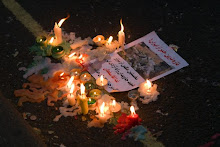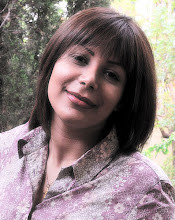I made the Clause 28
Tea Set while still learning pottery at evening classes in 1988.
Clause 28
Clause 28, as it came to be known, sought to prohibit local
government from both ‘promoting’ homosexuality and from publishing ‘material
with the intention of promoting homosexuality.’ Further, it specified that ‘the teaching in any maintained school of the
acceptability of homosexuality as a pretended family relationship’ would also
be prohibited. While all branches of the gay community were outraged at the
bill as a whole, the latter part, referring to the ‘pretended family
relationship,’ seemed to target lesbian mothers in particular. This, I suspect,
was one of the driving forces behind many of the specifically lesbian protests
which occurred consistently throughout that year.
The Tea Set
The Clause 28 Tea Set
comprises eight cups or mugs, eight plates, two teapots, a jug and a sugar
bowl. The cups and mugs record the most imaginative and, in some cases,
notorious of the political protests by lesbians. Two stand out to this day as
dazzlingly audacious: the ‘lesbians are out,’ protest, (February 2, 1988), in
which three lesbians abseiled into the chamber of the House of Lords from the
public gallery; and the invasion of the BBC Six O’Clock News, (May 23, 1988),
with Sue Lawley and Nicholas Witchell. I am proud to say that I witnessed the
abseiling lesbians. I was in the gallery at the time having been lobbying
parliament earlier - another of the cups records my vastly more prosaic
efforts. Two more cups record a ‘kiss-in’ at Eros, in Piccadilly Circus,
London, and the overnight appearance of a number pink triangles attached to
statues of the great and good, also in London. There is a scene from the
protest march in Manchester; a protest showing a group of women, dressed as
suffragettes, who chained themselves to the railings of Buckingham Palace,
(March 8 1988); and a protest in which I took part, at the Ideal Home
Exhibition in London’s Olympia where a group of twenty-five lesbians occupied
one of the houses, on March 13 1988, Mothering Sunday, and threw
pink protest leaflets out of one of the upstairs windows and unfurled a huge
banner from another supporting the rights of lesbian mothers.
One of the teapots records the Manchester march, (Februray
20 1988), and the other, triangular one, the various lesbian conferences and
events that took place that year. The images for the Manchester march were all
from photographs that I took and still have. The milk jug was a moment to send
up our own seriousness – it pictures a herd of assorted animals sporting pink
triangles, including rat, demanding rights. A little self-irony was an
essential part of the political survival tool-kit.
How it got to the Pankhurst Centre
I kept the tea set until about 2001, when I moved from
Todmorden to London. I felt I had hung on to it for long enough and asked the
Pankhurst Centre if they would like it. They accepted the donation along with
some other plates and we stayed in touch for a year or so. Some time
later, I contacted the centre and was told that they knew nothing of these
ceramics. Much later, roundabout 2010, I tried again. This time I was advised
that there had been some building work done resulting in much of the centre’s
collection going into storage and some of it being distributed to other museums, but, again, the woman I spoke to knew nothing of
these pieces. I, meanwhile, consistently reassured myself that pots have a
habit of resurfacing when they’re ready.
How it was found
Dinah Winch, Director of Elizabeth Gaskell House, who knows
my work and included it ‘Fired Up,’ 2010, while she was working at Gallery
Oldham, contacted me to ask if some ceramics that had been found at the
Pankhurst Centre were mine. The current management had decided a food bank
would be a good idea. A room was available downstairs but was packed tight,
from floor to ceiling with junk, so tight that it was near impossible to get
into the room at all. Two courageous volunteers, Karen and Julie, set about
clearing it. Some days later, right at the back, having disposed of everything
else – they found a sink – ‘…with running water! “Who knew?!”…’ wrote Rachel Lappin,
Pankhurst Centre Manager, in an email to me. Under the sink, fully expecting to
find more rubbish, dried up cleaning materials and assorted spiders, they found
The Clause 28 Tea Set.
Rachel continues: ‘I don’t think you
will be able to appreciate their surprise and joy at finding and uncovering
these most beautiful pieces of ceramic work that we now know to be your tea set
and plates! Of course they called me down to inspect it, and I was – rarely!! –
speechless; the pieces literally took my breath away! We didn’t know anything
about any of the items, except that we assumed that they must have been made in
the ceramics workshops that we know were held at the Centre in the early 90s, although
of course we now know that this isn’t the case, and that they were made by you!
… I can honestly say that finding this work was most certainly a major
highlight of my time so far at the Centre; we just couldn’t believe what we had
come across, hidden away amongst a load of junk in a room in the basement!?’
Afterword
It has taken a while, but I do now have some understanding of why they were so excited. I guess it's not everyday that, while clearing junk from under a sink, you find a tea set recording a part of your own history. I was sure it would turn up somewhere in the centre. I didn't believe it had been re-donated - life just isn't like that. It is just much more likely that things get lost for a bit and then turn up, particularly in places where funding - and therefore workers - come and go like changes in the weather.
I'm hugely grateful to everyone at the centre and to their two resident PhD students, who are researching the centre's history, for the considerable trouble to took to trace me and let me know that it was, after all, still there. I'm also grateful they took the trouble to communicate their enthusiasm for tea set to me - it has reminded me why I made it in the first place.
Those interested in the
teaching of ceramics may also like to note that Rachel Lappin was not far wrong in her
assumption that the tea set was made at the centre in the 1990s. It was made in very similar circumstances, in an adult education class, in Brixton, but just a few years earlier. Some of the ceramics degree courses may be closing now but there are many more ways to learn and they
too can lead the student towards life as a professional, full-time maker. The Pankhurst Centre, I'm delighted to say, held a series of pottery classes for women. The Clause 28 Tea Set was on show to inspire and encourage their students - which is exactly what it should have been doing.















































